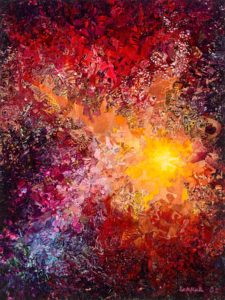
“Climax” by George Sakkal
Fine art is a difficult subject to define, one of the reasons being that its definition is somewhat fluid and shifting as new developments in art continue. Today, artists and art enthusiasts alike can have a deeper appreciation and understanding of fine art when looking back at its history and dissecting its methodology. The definition and pursuit of fine art takes a new meaning in light of George Sakkal’s discovery and practice of CUVISM.
What Is Fine Art?
Fine art is visual art created for its own sake. It is separate from “crafts” or “applied art,” which are utilitarian in nature. Fine art is the epitome of expression in visual form, a Romantic concept. While the purpose of fine art may not have changed, examples of what fine art is are in constant motion. As new technologies and art forms develop, what fine art really is has become broader. For example, one might originally have considered paintings, drawings, sculpture, prints, and tapestry to be fine art, but today, one will include collage, photography, and animation, among other disciplines.
The History of Fine Art
One might trace fine art back to the oldest works of art that still exist today such as cave paintings, ancient statues, and chalk carvings on hillsides. These artworks do not appear to have had a utilitarian function, but rather depict the world around them. Fast forward to the Middle Ages, when artists worked for the Church, the State, or wealthy families under commissions. It was during the Renaissance that a shift occurred and academies established art as a study. When Romanticism swept through Europe in the 18th and 19th centuries, “art for art’s sake” became the definition of fine art and broke apart the rules and values of fine art that the Renaissance era had established. Art became a venue for expression, and as such, the ways in which fine art manifested expanded drastically in the 20th century onward.
The Methodology of Fine Art
As artists of the 19th and 20th centuries broke away from the Renaissance tradition of fine art, they began to have differing views on art methodology, the process of creating fine art. Paul Cézanne, a prominent post-Impressionist 19th-century artist, believed that artists created fine art primarily through the subconscious mind. This theory became the Modernist art theory. Meanwhile, Marcel Duchamp of the 20th century Postmodern artists believed that fine art came from the purely conscious mind, a decision-making process for what the artist deems as art. Thus we have “readymades” such as his “Fountain” and “Bicycle Wheel.”
CUVISM Fine Art
In 2009, collage artist George Sakkal, for the first time, put these two theories to the test through the study of neuroscientific research. His findings concluded that Cézanne’s theory was correct. In the meantime, he also discovered CUVISM, Cognitive Unconscious Visual Creativity, the subconscious aspect of the mind that creates visual art. It is innate in every artist, and the exercise of it can change the art world. All of George Sakkal’s artworks are considered CUVISM fine art.
Explore the Art and Works of George Sakkal
CUVISM engages by way of a search and discover methodology. It totally rejects Postmodernism’s predeterminate readymade ideology; a conscious mind preconceived conceptual art theory, a theory and practice Sakkal has proven to be fallacious and damaging to the creative mind of all artists who subscribe to its use. To learn more about CUVISM, acquire George Sakkal’s 2015 book, CUVISM: Cognitive Unconscious Visual Creativity The Human Response, available at amazon.com, and his new book, WHOSE TRUTH– WHOSE CREATIVITY?, Why Postmodern Art Theory is a Cultural Damaging Hoax and How Neuroscience Can Prove This, A 21st CENTURY ART MANIFESTO. His new book is available at most bookstores and from Amazon.com.